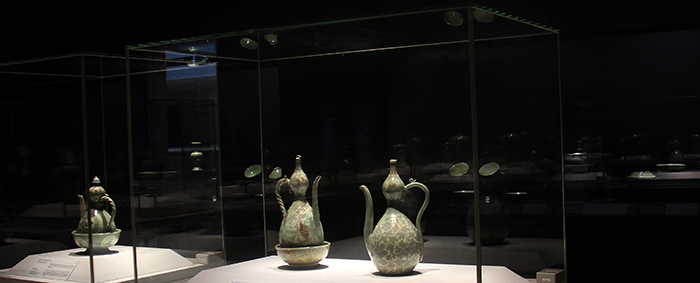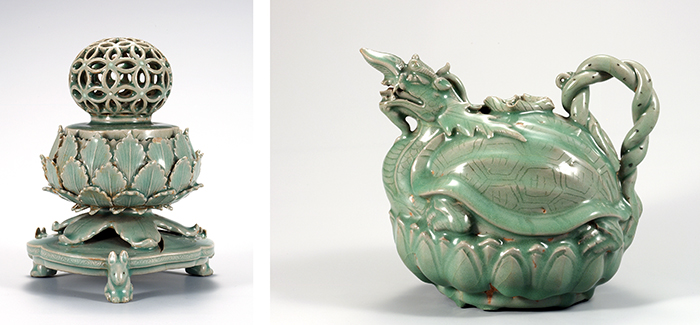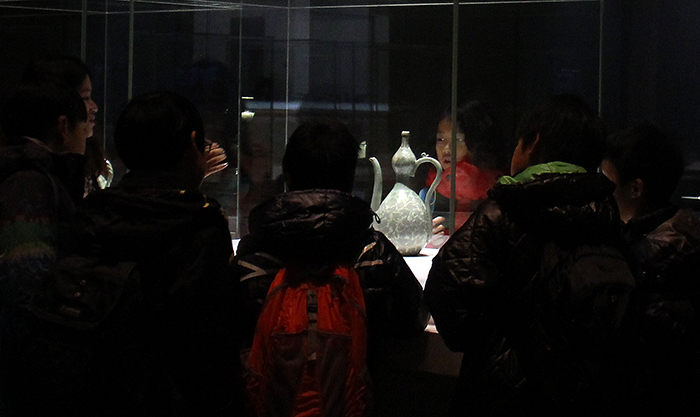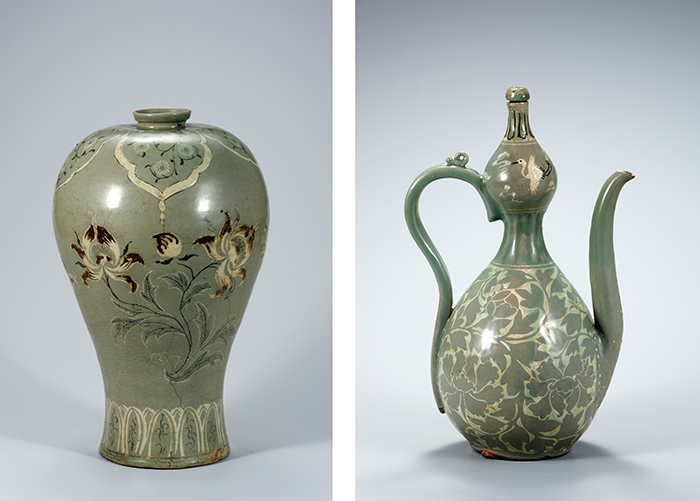Timeless beauty of Goryeo celadon wows visitors
“Blue as jasper, bright as crystal.”
So said Yi Gyu-bo (1168-1241), a renowned literary servant and scholar from the Goryeo Dynasty (918–1392), when he praised the beauty of Goryeo celadon in one of his writings. Goryeo celadon seems to hold a mysterious beauty thanks to its iconic blue-green color and its perfectly balanced shape. Cranes carved on the surface of the porcelain seem to fly skyward with their wings open. Peonies in full bloom are so vividly drawn on the celadon that their petals seem to breathe. The jade-colored incense burner placed on lotus petals seems to fill the gallery with a beautiful fragrance.
This beauty also captivated a scholar during China’s Southern Song Dynasty (960- 1279), Taiping Laoren (太平老人). Some 800 years ago he lauded the beauty of Goryeo porcelain by saying that, “jade-colored Goryeo celadon is the best under heaven” (高麗翡色 天下第一) (unofficial translation). People in the 21st century can now have the precious opportunity to appreciate such immortally beautiful craftwork. Closed for sometime due to renovations, the National Museum of Korea has now reopened its celadon gallery to the public. Jang Sung wook, associate curator of the museum, said the museum improved the overall environment of the exhibition hall by changing the lighting system and other display-related facilities. This will help people fully enjoy the celadon wares’ color, as close to nature as possible. The museum also extended the number of celadon displays to 160 from the previous 60 works.

The National Museum of Korea recently reopened its celadon gallery with improved display facilities. (Photo: Yoon Sojung)
Another feature which the museum took great care in addressing is the history of Goryeo celadon. Visitors can now learn and enjoy the ceramic’s history and beauty at the same time, learning how celadon evolved with time. The reopened gallery is composed of two parts: “Sculpture and Color” and “Decoration and Design” (unofficial translation). In “Sculpture and Color,” celadon craft from early Goryeo is on display. This section shows the gradual procedure by which Goryeo celadon got its unique grey-green color. This section also introduces well-known celadon works that show off their well-balanced artistic appearance, particularly the animal- or plant-shaped pieces. These celadon ceramics capture the eye of the audience with their sophisticated inlay patterns through various decoration techniques, such as engraving, embossing and carving.

The reopened celadon gallery helps visitors learn more about the history of Goryeo celadon and enjoy its beauty at the same time. (Photo: Yoon Sojung)

(From left) A celadon incense burner with an openwork cloisonne design, National Treasure No. 95; A turtle-dragon celadon pitcher, National Treasure No. 96
The displayed artworks in the first section show both the practical and beautiful sides of Goryeo celadon, as celadon was also used to contain tea, drinks or food. Some famous celadon works in this section are the celadon incense burner with an openwork design (National Treasure No. 95), a lion-shaped incense burner (National Treasure No. 60) and a turtle-dragon celadon pitcher (National Treasure No. 96).
The second “Decoration and Design” section focuses on inlaid celadon, which emphasizes the characteristics of Goryeo celadon. This part shows various celadon works that are decorated with inlaid cranes, peonies, clouds and waterside landscape designs. It also displays celadon decorated with underglaze copper-red patterns. It also displays celadon decorated with underglaze copper-red patterns and other types of Goryeo ceramics, such as white porcelain.

Elementary school students appreciate a gourd-shaped pitcher (National Treasure No. 116) inside the celadon gallery at the National Museum of Korea on November 27. (Photo: Yoon Sojung)

(From left) A celadon vase with an inlaid peony design, National Treasure No. 346; a gourd-shaped celadon pitcher with an inlaid peony scroll design, National Treasure No. 116 (Photos courtesy of the National Museum of Korea)
More information about the gallery is available at the museum’s homepage (https://www.museum.go.kr), with information available in nine languages. The museum is closed every Monday. It offers free admission and is open late until 9 p.m. on Wednesdays and Saturdays.
By Yoon Sojung
Korea.net Staff Writer
